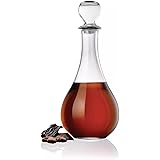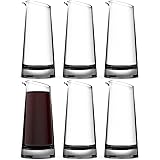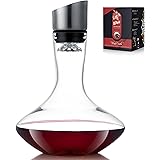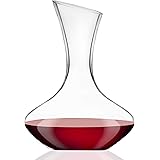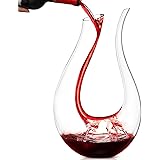Understanding the nuances of wine can be a delightful journey, yet the selection of appropriate glassware often presents a perplexing challenge. Many enthusiasts find themselves pondering which glass best complements their chosen varietal, or indeed, if a single type of glass might suffice for all their needs. This confusion, however, can be easily resolved through an informed exploration of wine glass design and functionality. As highlighted in the accompanying video, the right glassware serves as much more than just a vessel; it significantly enhances the sensory experience of every sip.
This comprehensive guide aims to demystify the world of wine glasses, offering a buyer’s perspective on what truly matters when making your selection. From the fundamental anatomy of each piece to the specialized designs for different wines, we shall navigate the considerations that contribute to an optimal tasting experience. By delving into the craftsmanship and practicalities of various wine glasses, a clear path towards making confident choices for your home bar or next gathering will be illuminated.
Your Comprehensive Guide to Choosing the Perfect Wine Glasses for Every Occasion
The intricate design of a wine glass is not merely for aesthetic appeal; rather, it is meticulously engineered to influence the wine’s aroma, flavor, and overall presentation. Each component plays a crucial role in shaping the interaction between the wine and your senses. Consequently, a deeper appreciation of wine is often achieved when these specific design principles are understood and applied.
The Essential Anatomy of a Wine Glass
At its core, a traditional stemmed wine glass is composed of four primary elements: the rim, the bowl, the stem, and the base. These parts collectively work in harmony to elevate your wine-drinking experience. Understanding their individual functions allows for a more informed selection process, ensuring that each glass serves its intended purpose effectively.
The **rim**, often the first point of contact with the wine, is critical for seamless delivery to your palate. A thin, finely crafted rim allows the wine to flow effortlessly from the glass, minimizing any interference with the tasting experience. Conversely, a thicker, rolled rim can disrupt this smooth transition, potentially altering the perception of the wine’s initial characteristics. The quality of the rim is frequently indicative of the overall craftsmanship of the glass, contributing significantly to a more enjoyable sip.
Central to the glass’s function is the **bowl**, which operates much like a miniature decanter for the wine. Its shape, width, and height are paramount in influencing how oxygen interacts with the wine, thereby affecting the development and concentration of its aromas. The bowl’s curvature also dictates how these aromatic compounds are gathered and delivered to your nose, presenting them in an optimized fashion. A carefully designed bowl facilitates the “swirling” action, which further encourages aeration and the release of complex scents.
The **stem** serves a vital role, acting as a buffer against temperature alteration during consumption. By providing a comfortable holding point, the stem ensures that the heat from your hand does not inadvertently warm the wine in the bowl. This is particularly important for wines sensitive to temperature fluctuations, such as whites and sparklings, where maintaining chill is essential. Longer stems are often associated with a more elegant aesthetic, while also offering increased distance for thermal insulation.
Finally, the **base** provides the necessary stability, anchoring the glass securely on various surfaces. A wide, flat base is particularly beneficial for the swirling motion, which is crucial for aerating the wine and releasing its bouquet. The robust construction of the base contributes to the overall balance and durability of the wine glass, preventing accidental spills and enhancing confidence in handling.
Decoding Different Wine Glass Types
The vast world of wine encompasses a diverse range of styles, each with unique characteristics that can be either accentuated or diminished by the choice of glassware. Therefore, understanding the specific designs tailored for red, white, and sparkling wines becomes paramount for maximizing enjoyment. This specialized approach to wine glasses allows for an optimal presentation of each varietal’s inherent qualities.
Red Wine Glasses: Embracing Aeration and Aroma
Red wine glasses are characteristically distinguished by their larger and wider bowls. This expansive design provides a generous surface area for the wine to interact with air, facilitating crucial aeration that softens tannins and allows complex aromas to fully develop. Think of the bowl as a wide-open canvas where the wine can breathe and truly express its character. Consequently, these glasses are ideal for bolder reds that benefit from significant exposure to oxygen.
The wider bowl encourages these gorgeous aromas to ascend and concentrate, especially when the rim tapers inwards. Conversely, a less angled rim permits more air ingress, further aiding in the opening up of a robust red wine. Interestingly, the versatility of these larger wine glasses extends beyond wine, making them excellent choices for aromatic spritzers or gin and tonics, where the botanicals benefit from ample swirling space. Even bold orange wines, with their complex profiles, find a suitable home in a red wine glass.
White Wine Glasses: Preserving Crispness and Chill
In contrast to their red wine counterparts, white wine glasses typically feature a smaller bowl, both in width and height. This reduced size is thoughtfully designed to preserve the delicate aromas and maintain the cooler temperature that white wines require. A smaller surface area limits oxygen exposure, which helps in retaining the crispness and nuanced floral or fruity notes that define many white varietals. Maintaining that chill is an absolute priority for these wines.
The more modest bowl keeps the wine closer to the nose, allowing for an intimate appreciation of its subtle aromatics without overwhelming the senses. Furthermore, having distinct glassware for reds and whites proves incredibly practical when hosting. This simple differentiation allows hosts to effortlessly identify guests’ preferences, ensuring accurate refills and a smoother entertaining experience. It really simplifies the logistics of serving multiple wines.
Sparkling Wine Glassware: Celebrating Bubbles and Beyond
The selection of sparkling wine glasses offers a truly delightful array of choices, each designed to highlight different aspects of bubbly beverages. Traditional flutes, characterized by their narrow diameter, are specifically engineered to minimize surface area exposure. This design effectively preserves the effervescence, ensuring that your sparkling wine remains bubbly for an extended period, thus extending the joyous experience.
Historically, coupes were the predecessors to flutes, offering a wide, shallow bowl that allowed for close appreciation of the wine’s aromas. While they beautifully showcase the bouquet, their expansive surface area means that bubbles dissipate much faster, making them perhaps less ideal for extended enjoyment of a vibrant sparkling wine. However, their elegant design makes them superb choices for crafting and serving classic cocktails, adding a touch of vintage sophistication.
A contemporary evolution in sparkling wine glasses includes the tulip flute, which combines the best attributes of both flutes and coupes. This design features a wider bowl that tapers towards the rim, allowing for a gentle swirl to enhance aroma release, a feature often lacking in straight flutes. Connoisseurs of fine champagne, seeking to explore the complex layers of their pour, frequently opt for this style. The tulip shape supports a more comprehensive sensory evaluation, bridging the gap between bubble preservation and aromatic expression.
The Versatility of Stemless Wine Glasses
For those prioritizing practicality and casual enjoyment, the stemless wine glass presents an excellent alternative to traditional stemmed varieties. These glasses are inherently fuss-free, making them ideal for everyday use and less formal settings. The absence of a stem makes them considerably less prone to tipping, offering a robust and stable option for any occasion where spills might be a concern.
Their compact design ensures easy storage and makes them dishwasher-safe, simplifying post-party cleanup significantly. However, it should be noted that the lack of a stem means direct hand contact with the bowl, which can transfer warmth to the wine. Yet, their versatility is unmatched; a stemless glass seamlessly transitions from serving red or white wine to whiskey, cocktails, water, or even small snacks like olives. This multifunctionality makes them a true workhorse in any kitchen or bar collection.
The All-Purpose Solution: Universal Wine Glasses
Amidst the specialized array of glassware, the universal wine glass emerges as a remarkably versatile and efficient solution. This innovative design is meticulously crafted to accommodate a wide spectrum of wines—be it red, white, orange, or sparkling—without compromising the tasting experience. Its ingenious proportions and thoughtfully designed tulip-shaped bowl enable any type of wine to flourish within its contours. The engineering behind these glasses is truly impressive, often the result of extensive research.
Consequently, the universal wine glass becomes an invaluable asset for those with limited storage space or a desire for a minimalist approach. It perfectly caters to individuals who prefer a single, high-quality option that reliably performs across various varietals. Embracing a universal glass allows for an uncomplicated yet sophisticated wine journey, demonstrating that one expertly designed piece of stemware can indeed do it all.
Understanding Glass Production: Handmade vs. Manufactured
The production method of wine glasses significantly influences their aesthetic, durability, and tactile qualities, presenting a choice between artisanal craftsmanship and technological innovation. Handmade glasses, often celebrated for their unique charm and delicate feel, are typically mouth-blown from a single piece of glass. This traditional process allows for an exceptionally thin rim and a seamless silhouette, creating a graceful and elegant vessel that appeals to those who appreciate bespoke items.
Conversely, manufactured wine glasses, produced through advanced machine techniques, offer a different set of advantages. While achieving the exact thinness of a handmade rim might be challenging, modern manufacturing processes come remarkably close to replicating this delicate quality. A prime example is found in the Schott Zwiesel Vervino glasses, which are ingeniously reinforced with titanium. This remarkable technological integration grants them incredible strength and resilience, making them significantly more resistant to breakage and chipping.
The durability of these manufactured glasses is truly impressive, offering peace of mind, especially in busy household or hospitality environments. Furthermore, machine-made glasses are often available at a more approachable price point, making high-quality, durable stemware accessible to a broader audience. Therefore, the choice between handmade and manufactured often boils down to a preference for artisanal uniqueness versus robust practicality and value.
Selecting Your Ideal Wine Glass: Practical Considerations
Ultimately, the quest for the perfect wine glass is a deeply personal journey, shaped by individual lifestyle, aesthetic preferences, and practical needs. It is imperative that the chosen glassware not only enhances the wine experience but also seamlessly integrates into your daily life. Thoughtful consideration of these factors will lead to selections that bring enduring satisfaction and enjoyment.
For instance, individuals residing in compact urban environments, such as a New York City apartment, might prioritize glassware with a small footprint or stackable design. Such space-saving solutions ensure that limited cabinet space is utilized efficiently without sacrificing functionality or style. Similarly, a universal or multifunction glass could be the optimal choice for those seeking maximum utility from minimal pieces, effortlessly transitioning from wine to water or cocktails.
However, if the desire is for a truly special piece, perhaps one with a unique design or a vibrant pop of color, then that personal taste should undeniably guide the decision. The joy derived from holding an exquisitely designed glass can significantly elevate “me time, wine time,” transforming a simple sip into a moment of luxurious indulgence. The selection of wine glasses should always be an extension of one’s personal style and a celebration of individual preference.


